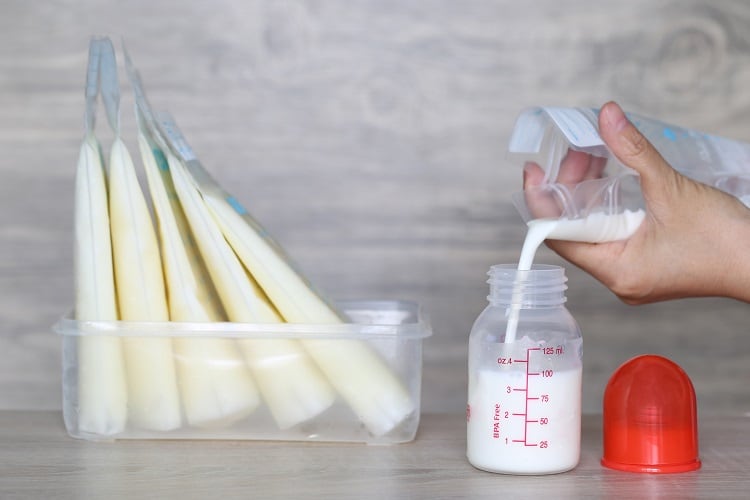When food tech companies talk about precision fermentation in dairy, you can safely bet they’ve got a key whey protein, casein, or lactoferrin in mind.
But in the UK, Better Dairy is changing tack. Long focused on animal-free casein for alternative cheese production, the food tech start-up is expanding R&D efforts to develop human osteopontin for the baby formula market.
What is osteopontin?
Osteopontin is a protein found in breast milk. It’s believed the protein plays a “major role” in growth and immune system development during the early stages of an infant’s life.
Although Better Dairy has yet to run efficacy studies, research suggests the protein increases calcium absorption; boosts gut health by enhancing nutrient absorption and efficiency in the intestine; and enhances immune cell stimulation. Osteopontin is also highly expressed in the brain during infancy, leading scientists to believe it’s important for normal brain development.
Osteopontin is present in bovine milk, but in much lower concentrations. Breast milk can contain up to 15 times as much osteopontin, marking an obvious divergence between cow’s milk-based infant formula and breast milk.
“We think it presents an exciting opportunity to reduce some of the discrepancies in development between breast-fed and bottle-fed infants,” explains Trishala Bopanna, director of strategy and partnerships at Better Dairy.
How Better Dairy makes precision fermentation-derived osteopontin
In food, precision fermentation technology uses microorganisms as 'cell factories' to produce complex molecules such as protein.
In Better Dairy's case, the company is working with both fungal and yeast strains in the precision fermentation process. As a general rule, the start-up is using yeast strains for the higher value proteins, such as osteopontin, and fungal strains for commoditised ones such as casein.
"Our foundational work on casein and its post-translational-modifications (PTMs), for which we have a published patent, enabled us to get osteopontin off the ground so quickly," explains Trishala Bopanna, director of strategy and partnerships.
Why is Better Dairy pivoting to osteopontin?
Better Dairy was founded in 2019 with a focus on precision fermentation-derived casein.
Initially, the start-up was putting R&D efforts into finished products for the hard aged cheese market, using its precision fermentation-derived casein.

Better Dairy’s most recent pivot to human milk osteopontin is not a sign it’s putting down tools on animal-free casein. Far from it. The start-up has succeeded in expressing all four components of casein (αS1, αS2, β and κ-casein) in a single yeast host and maintains its commercialisation plans. “The casein ambition hasn’t gone,” explains Bopanna. “Casein remains very much within our fibre and something we want to bring to market.”
So why isn’t Better Dairy putting all its efforts into pushing its casein through from R&D to regulatory approvals?
The answer is two-fold. To start with it could take Better Dairy longer to achieve a competitive price point for casein with economies of scale. The start-up is shifting from high volume and low value to the inverse, since milk contains much less osteopontin than casein, says Bopanna. “Casein will be a longer journey, and it makes sense to monetise higher value targets first. It’s an evolution to get us to work better commercially.”
The other driver lies in the osteopontin potential. The protein is less complex than casein, and early work expressing osteopontin proved very promising, recalls the partnerships and strategy lead. “That got us thinking, this could be a really big opportunity we’re overlooking.”
The osteopontin opportunity in food and beverage
The innovation potential that next-generation technologies bring to infant formula is enormous.
Whey protein lactoferrin, for example, helps regulate iron absorption and contributes to gut health. When filtered from bovine milk, it’s a popular ingredient that can help premium baby formula better mimic breast milk. It can also be made in a lab: Singaporean start-up TurtleTree has received regulatory approval in two markets for its precision fermentation-derived lactoferrin.
Osteopontin is also currently sold to the infant formula market. “Osteopontin has been on a lot of people’s radars for a while. The challenge has been about quantity: you’d need about 40,000L of cow’s milk to filter out one kilogram of osteopontin,” explains Bopanna. Recombinant osteopontin protein also exists - made using DNA technology - but costs are prohibitively expensive.
Better Dairy sees a big opportunity for precision fermentation-derived osteopontin. “We’re excited about unlocking a steady supply of osteopontin through precision fermentation,” says the director of partnerships and strategy. “And we’re doing the human version of it.”

Outside of infant formula, other opportunities in food and beverage exist. The protein could find an opening in the women’s health and healthy ageing market, as a means of supporting bone health. Literature also suggests osteopontin can promote cell adhesion and tissue repair, which could lead to new osteopontin-enriched products in the sports nutrition space.
Where will next-gen osteopontin enrich infant formula?
Better Dairy is already expressing osteopontin at concentrations compatible with commercialisation, and through upstream and downstream processing optimisations expects the cost will continue to come down.
The company is aiming to achieve Self-affirmed GRAS certification in the US by the end of the year, using it as a strong signal to the market. “It demonstrates that we’re serious, that we have the necessary capabilities, and that we’ve validated the safety of our product,” explains Bopanna.
Better Dairy is already engaging with infant formula brands to help speed up its route to market, with plans to initially apply for regulatory approval in the US. The company will simultaneously apply to the UK and EU, before concentrating on China - a country that not only boasts the largest infant formula market in the world, but one that appears open to ingredients innovation.
“If we take the adult lactoferrin market for example, there are a lot more products on the market in China than there are in the rest of the world.
“They appear to have a higher appetite for innovative solutions, and big players we’ve spoken to in China have expressed interest in osteopontin.”


